Inside The Great Stalacpipe Organ: The World’s Largest Musical Instrument
This story first appeared in Trust Me, I’m a Scientist, on April 15, 2015.
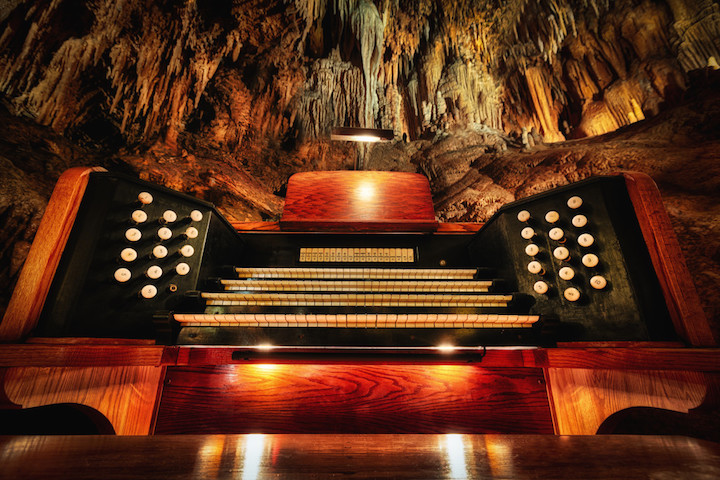
The Great Stalacpipe Organ
In 1954, on his 5th birthday, Robert Sprinkle was given a choice by his father, Leland Sprinkle: have a traditional birthday party, or take a tour of one of Virginia’s most famous caves, Luray Caverns. Robert chose the cave tour, and soon the Sprinkle family descended below the surface of the small town of Luray to view its main attraction.
When they arrived at a part of the cave dubbed “The Throne”, their guides indulged in a regular custom: “Playing” the cave’s stalactites like the keys of a marimba. “The guides had a habit of taking out a little rubber rod and tapping out ‘Mary Had a Little Lamb’,” Robert now recalls. “They had noticed that these different stalactites, when hit, made a sound, and they had identified several notes.”
After the tour, Leland Sprinkle asked to speak with the cave’s owner, Ted Graves. They had coffee in the cafeteria, and Sprinkle explained that he was an engineer and an organist, and that he could make a musical instrument out of the stalactites of Luray Caverns. He could turn the cave itself into a giant instrument, the only one of its kind.
“[Mr. Graves] should have said ‘Are you kidding?’,” says Robert. “But he didn’t. He said ‘Sure, why not?’” Sprinkle spent the next three years constructing his organ. He combed Luray Caverns for stalactites of different pitches and wired up hammers to strike them when an organ key was pressed, all while finding ways to keep a complex electrical system from going to hell in a forever-damp 54 degree cave.
The “Great Stalacpipe Organ”—as Washington Post music editor Paul Hume dubbed it—debuted in 1957, but Leland Sprinkle would spend the rest of his life continuing to work on it in one form or another. Underneath the town of Luray, he had built his legacy, after navigating so many twists, turns and false starts in the years prior.
Leland Sprinkle’s Shortcut Detail
“My dad came of age during the Depression, and he had a number of opportunities that evaporated,” Robert Sprinkle tells me over the phone. He is now a physician and an associate professor at the University of Maryland’s School of Public Policy. “He ended up making his way in the world in a fashion that wasn’t entirely what he had in mind.”
Leland Sprinkle was set to begin a PhD program in physics at Harvard when his father was struck with a case of appendicitis. The appendix burst and Sprinkle’s father died, leaving Leland to care for his mother. His Harvard plans curtailed, Sprinkle worked for various arms of the World War II-era U.S. government. He worked in the Treasury Department, the Federal Housing Administration, and later, the Pentagon. He worked on the Norden bombsight and the UNIVAC computer. He taught pre-flight calculus in the Navy. Along the way, he studied organ at the Peabody Conservatory, and earned patents for several inventions.
“Wherever he ended up, he made contributions that typically reduced the number of equations needed to solve a multivariable problem,” Robert Sprinkle says. “He did it again and again and he kept referring to himself as having been assigned to the ‘shortcut detail’.” According to Robert, his father never quite got the credit he deserved for much of his work, but “this was sort of his story, and he was surprisingly not bitter about it.”
Employees of Luray Caverns remember Leland Sprinkle as a unique man. A genius in matters of math, science, and music, he was also a willing teacher, and someone who could seemingly talk comfortably with anyone.
“He was always very kind to me,” says John Shaffer, Luray Caverns’ marketing director, who has been there for forty years. “He was always taking time to show a little kid like me why something worked. It didn’t take him ten seconds to go over my head, but he was always trying to include even the younger people helping him.”
Larry Moyer was a teenager when he started work at Luray Caverns as a tour guide, over three decades ago. Moyer made a model of the organ’s automatic player system for a school project, and when Leland Sprinkle heard about it, he asked to meet the young man, and offered to let him tag along for some of the work in the cave. Today, Moyer is the manager of maintenance operations for Luray—and the chief organ engineer.
“He was a very interesting man, a very good man,” Moyer tells me. “He loved to learn and he loved to see other people learn.”
Moyer, like many people who aided Leland Sprinkle in the creation and maintenance of the organ, had an interest in electronics, but no formal training as an engineer. Not that it mattered. There was no engineering blueprint for The Great Stalacpipe Organ at all; it had to be configured from the (under) ground up. “You can’t just go down to the store and buy a part for a Stalacpipe Organ,” Moyer says.
In The Cave
One day in February 2011, Paul Malmström donned his white dinner jacket, set up a stereo mic on a boom stand in the main “Cathedral” of Luray Caverns, and placed a Nagra tape recorder on a chair in an attempt to capture history.
Malmström is one half of the group Pepe Deluxé. He and partner James Spectrum call themselves an ‘inter-continental collective orchestra’. They had composed, and then spent years trying to get the opportunity to perform, the first piece of original music written specifically for The Great Stalacpipe Organ, titled “In The Cave”.
“Recording an unusual instrument is often a challenge because you need to find out both what and where it sounds good,” Spectrum tells me in an email exchange. “I tracked down most of the existing Stalacpipe recordings and those really helped us to realize that we should avoid repeating notes, especially in the lower register. We also decided that the tempo of the composition should be quite slow as there is plenty of reverb in the caverns – reverb that tends to blur faster notes.”
The organ’s stalactites cover over 3.5 acres of the cave, and each one is wired individually. Playing a note on the organ console sends a signal through a wire to a “solenoid”, a type of electromagnet set to trigger a coiled rubber hammer, which then strikes the stalactite. Pickups are employed to help amplify the stalactite sounds, and with sometimes acres of wire to travel through to get to a stalactite (and then an amplification system to travel back through to get to the performer) some lag or latency in the signal is apparent. “Speed metal heads beware,” Malmström says. “This instrument isn’t something you’ll do lightening fast 16th note runs on for sure. The keys have to be pressed with tender determination.”
The organ’s main console was built by Virginia’s Klann Organ Supply. (They still assist with refurbishing.) Much of the rest of the design and construction is focused around a never-ending battle with the cold and moist conditions of the cave. The organ sits on a heated platform, and additional heaters have been rigged up inside the console. The control room holding the main power source is covered in heat lamps.
“I joke that it’s like the surface of the moon,” John Shaffer says. “Anything that can go wrong, will go wrong. It’s a hostile environment. It’s damp, and water seeps into every piece of equipment. Even though it’s sealed up with ways to keep the water out, when it’s down there for 365 days a year for decades…”
Robert recalls working with his father at home on a solution for keeping the stalactite pickups safe and dry. “When [my father] began discovering rocks that were too far away [to be heard acoustically] he needed to figure out a way to amplify something that was constantly being dripped on… We had a hot plate and an aluminum pot at home and we took very large chunks of beeswax and melted the beeswax, then dipped these magnetic pickups in the beeswax. It didn’t interfere with the magnetic field at all, but it kept the wiring from getting corroded.”
Sprinkle also had to design a way for the organ to play continuously to throngs of visiting tourists, so he fashioned an apparatus out of a spinning metal drum, covered with an outer layer of plastic. Sprinkle melted holes into the plastic surface so that it functioned much like a player-piano roll: Metal brushes would make contact with the metal drum where the holes were, triggering notes in the same way that pressing a console key would. Being a trained concert organist, Sprinkle of course did the transcriptions and sheet-making himself.
During our interview, Robert Sprinkle confesses that he only learned about a specific part of the organ’s functionality that day as he went through some of his father’s old paperwork in preparation for our talk. “If you look at the organ console, it’s preposterously in excess of need, really, with multiple keyboards (there are 4). I thought this was only for show–to say it was more like an organ. What I read today [is that] he envisioned an antiphonal organ: there would be rocks of a different character in different places… There would be a louder set and a softer set. You’d have parts coming from your right, or parts coming from behind you, so that you’re actually inside the instrument.” Leland Sprinkle was trying to bring us his organ in full Surround Sound, an idea that sadly came and went with the decision to amplify the organ’s stalactites.
Despite all of the ingenuity Leland Sprinkle displayed in Luray Caverns, none of his established patents relate to his work there. As Robert Sprinkle points out, “He never patented anything he invented for the cave. He wanted all of that to be freely available.He really thought what he was doing there was worthwhile and he didn’t want to do it in any proprietary fashion.”
Welcome to Luray
According to John Shaffer, Luray Caverns gets about 500,000 tourists per year. It’s a popular destination among DC insiders (the Obama family has visited twice), vacationing east-coasters, travelers passing through on their way to Shenandoah National Park or George Washington National Forest, and couples, who come to get married in the Cathedral to the sounds of the organ.
(Robert Sprinkle suggested this idea to his own wife before they were married. In a sense, Leland Sprinkle could have posthumously performed at his son’s wedding.)
Tourism is what keeps this town of 5,000 afloat, and Leland Sprinkle’s organ is a big part of that. “The organ has been instrumental–no pun intended–in maintaining our popularity,” says John Shaffer.
“It’s a U.S. Natural landmark now, which is a designation bestowed by the Department of The Interior. The Park service inspects our cavern once a year to make sure we aren’t doing anything to harm the environment, because they want us to maintain this for generations to come.”
The irony of course is that Leland Sprinkle’s tinkering in Luray Caverns—including his sanding of some stalactites to fine-tune them—would almost certainly get him thrown out of any natural landmark location today, if not arrested outright. Robert Sprinkle says his father was amused by the idea that, because of the natural growth of stalactites, the instrument would have to be tuned every thousand years or so. If some version of the U.S. government and its park service exists in a thousand years, that could mean trouble with the Caverns’ landmark status.
I wonder about Robert Sprinkle’s claim that his father’s life wasn’t what he had in mind. With his creativity, and a PhD in physics from Harvard, Leland Sprinkle could have been on the road to becoming another Einstein before his father died. But as a grown man with children of his own, Leland Sprinkle saw something in Luray Caverns that told him it could and should be his true life’s work. I ask Robert what it was about the cave’s potential that consumed Leland, and he takes a minute to sift through his own emotions.
“He thought that he could make an instrument out of an ancient thing—something that had existed for millions of years, that had a mellifluous potential that he could unlock. There was just the notion that there was something in there that he could liberate. To him, it wasn’t a sideshow. To him it was a mission and he didn’t want it to die with him. He wanted it to be maintainable, usable—he wanted other people to be able to use it.”
Robert Sprinkle means his father wanted people to be able to play the organ after he was gone. But it strikes me just how many other ways Leland Sprinkle’s organ is used today: The small town of Luray uses it to boost tourism. Couples get married to it and fathers take their sons to see it on birthdays. Pepe Deluxé used it to make music history.
“Oh man. I’m Googling ‘Stalacpipe Organ’ all the time to show off to friends and strangers alike,” Paul Malmström says. “Most think it’s a film set, while I naturally explain I’ve had a chance to man-handle the 8th wonder of the world.”
Initially, neither John Shaffer nor Larry Moyer intended to stay at Luray Caverns forever, but Leland Sprinkle and his organ helped them build sustainable and fulfilling careers there for the long-term. (Luray also employs a full-time machinist that works specifically on organ parts.) Moyer uses the organ as a teaching device, a way for an older generation to impart specialized knowledge to a younger one, reminiscent of his teenage days and nights in the cave with Leland Sprinkle.
“I got two young guys I’m teaching right now, and I kind of let them work as a team. I teach them in the same method Mr. Sprinkle taught me. I give them little projects to work on, and they go down and work on it, and I leave them alone and give them time to try and figure it out themselves. That’s the way Mr. Sprinkle taught me. He’d let me mess with it for a few hours or days before he came in and helped me solve a problem. I think you learn better that way. It worked for me anyway.”
The Great Stalacpipe Organ may be Leland Sprinkle’s greatest invention because it wasn’t part of his “shortcut detail”. On the contrary: There will always be water to keep out of the electronics, solenoids to clean, coils to rebuild, and consoles to re-key. And there will always be a need for the people and specialized knowledge to maintain it. Leland Sprinkle built an instrument that sustains the lives of those that continue to give it life.
Blake Madden is a musician and author who lives in Seattle.
Please note: When you buy products through links on this page, we may earn an affiliate commission.







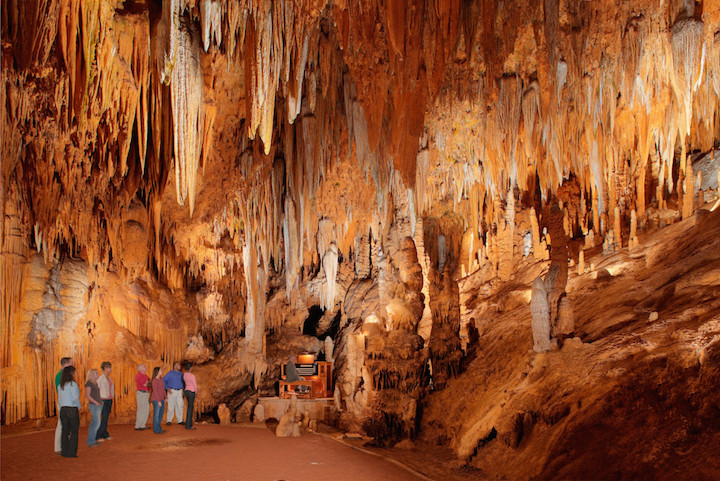
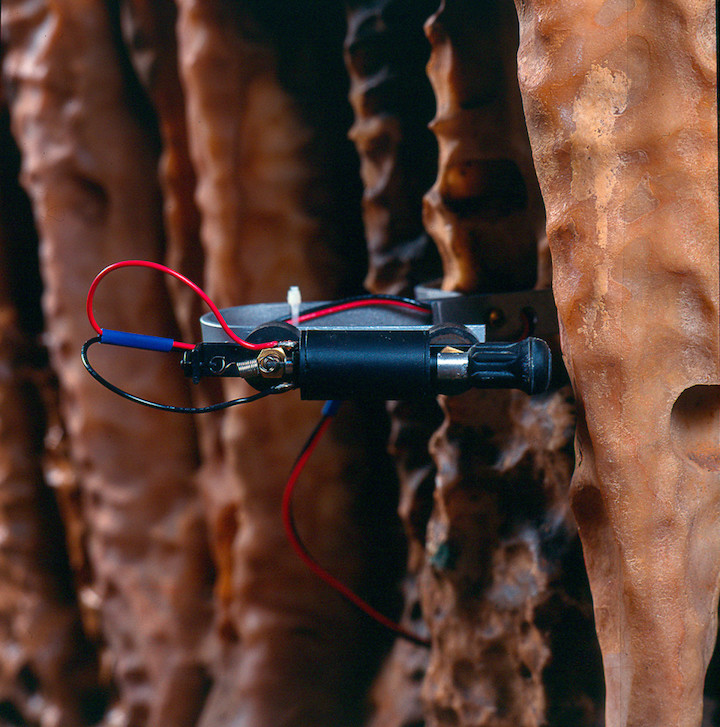
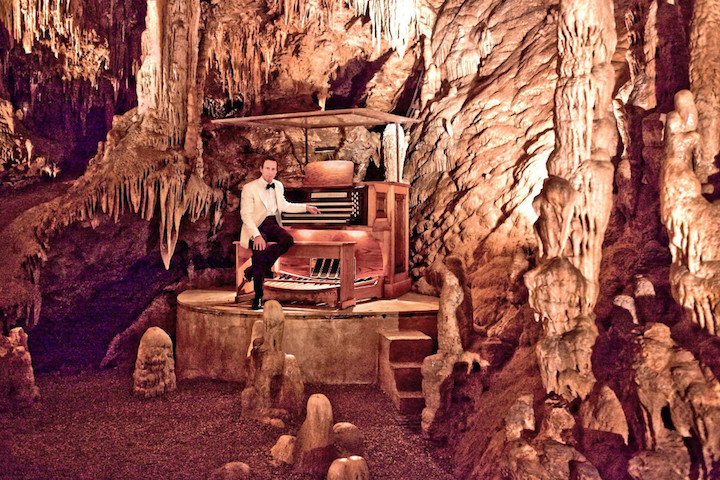
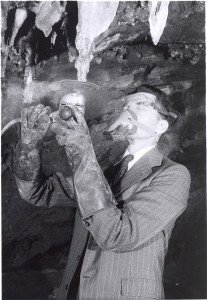
MisterWade
June 30, 2016 at 7:26 pm (8 years ago)Thanks for this article! I’ve been down in Luray Caverns 4 or 5 times in my life. The first time, I was 12 (I’m 63 now). The experience of standing in that chamber and hearing that delicate sound coming from all directions is absolutely beautiful. You can’t tell by the stereo recording, but it is the essence of surround sound. Some of the hammers are maybe 25 feet away and the reverb is incredible. There’s also no background noise. If you’re ever in western Virginia, it’s worth the trip for a unique experience. Not to mention, the rest of the cavern is pretty incredible, too.